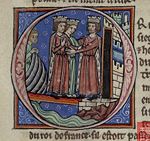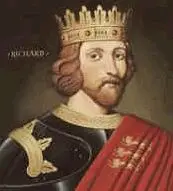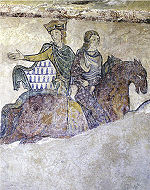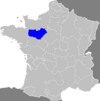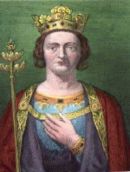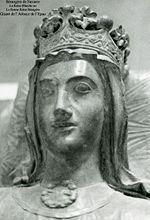Berengaria of Navarre
| Berengaria of Navarre | |
|---|---|
| Queen consort of the English | |
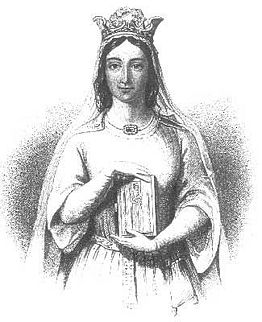
| |
| Consort | 12 May 1191 – 6 April 1199 |
| Consort to | Richard I of England |
| Titles | |
| The Queen Dowager The Queen Infanta Berengaria of Navarre | |
| Royal House | House of Plantagenet House of Jiménez |
| Father | Sancho VI of Navarre |
| Mother | Sancha of Castile |
| Born | c. 1165-1170 |
| Died | 23 December 1230 (aged 59–65) |
Berengaria of Navarre (Spanish: Berenguela, French: Bérengère; c. 1165-1170 – December 23, 1230), was queen consort to King Richard I, the lionheart. She was the eldest daughter of Sancho VI of Navarre (an area in the north of Spain bordering on Aquitaine) and Sancha of Castile. Berengaria was closely related to royalty in France and England as well as Spain.
Berengaria was very beautiful and well educated. Berengaria and Richard met when he was still a prince attending a tournament held by her father. It was as a result of this first "meeting" that she became betrothed to Richard, to whom she seemed devoted.
She married Richard on the route of the Third Crusade at Limassol, Cyprus. She spent very little time with him during their marriage, they had no children and she is known as "the only English Queen to never set foot in England." She never remarried after his death, when she was around 34 and he was 42.
After Richard's death, Berengaria was kept in poverty because she was never paid the dower money owed her, as dowager queen, by his brother King John while he was alive. She fought for her dower rights utilizing her relationship with the popes Honorius III and Innocent III and John's mother, Eleanor of Aquitaine. Only after John's death, did she receive what was due her from his son, King Henry III. And as John had been defeated in Normandy, Berengaria asked victorious King Philip II of France for her dower properties in Normandy which Henry had given her. He instead gave her the county of Maine in exchange. She ruled in Maine and established a Cistercian monastery at l'Epau in Le Mans, and lived in the abbey from 1204 until her death in 1230, and was buried at the abbey.
Life
Background
She was the eldest daughter of Sancho VI of Navarre and Sancha of Castile. Her maternal grandparents were Alfonso VII of León and Berenguela of Barcelona. She was a fourth generation descendant of Rodrigo Díaz de Vivar (El Cid). Berengaria was closely related to royalty in France and England as well as Spain. Her brother, Sancho el Fuerte, succeeded his father as king of León and her sister, Blanche, married Thibaut of Champagne, who was the grandson of Eleanor of Aquitaine and Louis VII of France. Blanche and Tibaut's son succeeded Sancho VII as king of Navarre. Blanche and Thibaut treated Berengaria as close family and offered her sanctuary in times of need.[1]
Marriage
Berengaria married Richard I of England on May 12 , 1191. She and Richard are said to have met years before their marriage, and contemporary writers report that there was an attraction between them.[2]
Richard had been betrothed many years earlier to Princess Alys, sister of King Philip II of France. Alys, however, became the mistress of Richard's own father, King Henry II, and was allegedly the mother of Henry's illegitimate child. A marriage between Richard and Alys was therefore technically impossible for religious reasons of affinity. Richard terminated his betrothal to Alys in 1190 while at Messina, Sicily.
Berengaria traveled with Richard's mother, Eleanor of Aquitaine to find him while he traveled on the Third Crusade, having wasted no time in setting off after his coronation. The two women had a long and difficult journey to catch up with him. They arrived in Sicily during Lent (when the marriage could not take place) in 1191 and were joined by Richard's sister Joan Plantaganet, the widowed queen of William II of Sicily. En route to the Holy Land, the ship carrying Berengaria and Joan went aground off the coast of Cyprus, and they were threatened by the island's ruler, Isaac Komnenus. Richard came to their rescue, captured the island, overthrew Komnenus and took control of Cyprus as a safe base for the crusade as a result, which proved immensely valuable in keeping the Frankish kingdoms in the Holy Land viable for another century.
He then married Berengaria in the Chapel of St. George at Limassol, many thought that the marriage would never have come about without his mother's great insistence as Richard was much more interested in war than marriage even though Berengaria brought a great fortune and the lands of Navarre-which bordered Eleanor's lands of Aquitaine-to the marriage.
Queen consort
Whether the marriage was ever even consummated is a matter for conjecture. Richard's sexual orientation has been hotly debated amongst revisionist historians; some claim homosexuality via phenomenon theory, while others present him as a notorious womanizer. Some sources have recorded him having at least one bastard son, Philip of Cognac (d. c. 1211).
Beginning at age 16, Richard battled again and again with his father for control of his mother's lands (his inheritance) in Southern France which eventually led him to make a close union with Phillip II of France in 1187 against his father. Nineteenth century chronicles about their union led some contemporary historians to believe it was also a homosexual relationship.[3] The final analysis resists a clear answer as to the lack of children for Berengaria and Richard. Their little time together may simply have been the problem.
After the wedding, Berengaria followed Richard to the Holy Land, where she and Joan stayed in Acre. After the failure of the Third Crusade, she left with Joan to France in September 1192, separately from Richard who, with the remnants of his army, hoped to return to protect his lands from his brother John's or King Philip's takeover. [4]
It was to be three years before Berengaria saw him again. Berengaria and Joan returned by sea stopping in Rome as guests of Pope Innocent III and were sheltered for six months under his protection. They were then conducted to Marseilles, accompanied by Alfonso II of Aragon, traveled through Provence; and for the final leg of the journey, were conducted to Poitou by Raymond of St. Gilles, don of the count of Toulouse—whom Joanna subsequently married. They reached Aquitaine (Poitou) ahead of Richard. It was from here that she learned of Richard's capture and imprisonment in Germany, and it was here that she remained during Richard's imprisonment (1192 - 1194), helping her mother-in-law to raise the enormous ransom. After his release, Richard returned to England and she did not join him. The marriage was childless, and Berengaria was thought to be barren.
When Richard returned to England, he had to regain all the territory that had either been lost by his brother John or taken by King Philip II of France now with his mother at his side. His focus was on his kingdom, not his queen. He was criticized by the church for living separate from his queen.
Richard was ordered by Pope Celestine III to reunite with Berengaria and to show fidelity to her in the future. Frightened when a severe illness nearly cost him his life, Richard publicly repented and rejoined Berengaria for Christmas at Poitiers in 1195. Richard obeyed and took Berengaria to church every week thereafter. But their time together did not last long, Richard left again for more battles with King Philip II of France (his former ally) and rebellious vassals. He gave his greatest attention for the next two years to the huge castle, Chateau Gaillard, which he was building at Les Andelys in Normandy, from which he could defend his lands. At this point, Richard named his brother, John, as his successor.
Berengaria was discouraged and retired to an obscure castle near Angers where she heard the news of Richard's death. He died on April 6, 1199, aged 42, as a result of a wound incurred while besieging the castle of a rebellious vassal. Before he died, he repented of his sins and took the Holy Sacrament-for the first time since his penitence and reconciliation with Berengaria, three years earlier. Eleanor was at Richard's deathbed and at his funeral at Fontevrault Abbey, but Berengaria, only a day away, does not seem to have been invited to either. When he died, she was greatly distressed, some think more so at being deliberately overlooked as Queen of England and Cyprus.
Dowager queen
Berengaria never visited England during King Richard's lifetime; and during the entirety of their marriage, Richard himself, spent just three months in England. There is evidence, however, that she may have done so in the years following his death. The traditional description of her as "the only English queen never to set foot in the country" would still be literally true, as she did not visit England during the time she was Richard's consort.
However, she certainly sent envoys to England several times, mainly to inquire about the pension she was due as dowager queen, as Richard's widow, which King John was not paying her. She lived in near poverty because of John. For a time she had taken refuge at her sister Blanche's court in Champagne, in northern France. Blanche had married Thibaut of Champagne, grandson of Eleanor of Aquitaine and Louis VII of France. Blanche and Tibaut's son succeeded Sancho VII as king of Navarre. Berengaria had been a witness at her sister's marriage, and may even have helped in arranging their marriage. Blanche took Berengaria in, when she was widowed and unable to claim her inheritance, as dowager queen, and later when her city was under interdict. Blanche and her son treated Berengaria as a close relation and even helped her to acquire the land she needed to found her lifelong dream of building a Cistercian monastery at l'Epau in Le Mans, Maine.
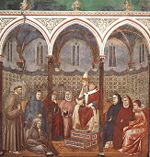
She entered into a long struggle to recover her dower lands which were in France; she was also supposed to receive Eleanor's lands in England, Normandy and Poitou after her death. Her champions were Pope Innocent III and his successor, Honorius III. The Church had a tradition of protecting widows and orphans, especially if the wrongdoers were royal. This scenario often gave the church a great opportunity to demonstrate the primacy of the Church versus temporal authority, the two great rivals of the thirteenth century. But only in 1220 after threats and even excommunications, did papal power prevail and Berengaria received a pension from England. Yet, despite various agreements and pressure from the papacy, John never paid his sister-in-law what was owed her. Regardless of threats of a papal interdict and Queen Eleanor's intervention, King John still owed her more than £4000 when he died. However, during the reign of his son Henry III of England, her payments were made as they were supposed to be, and once again the English monarchy was in good stead with the pope.
Ruler and patron
As a result of King John losing Normandy to France, Philip II of France made haste to seize her lands, but she claimed them as rightfully hers as dowager queen. Berengaria was able to petition the victorious Philip for her dower lands and he gave her the county of Maine in return for her properties in Normandy which he now controlled. She lived and ruled in Maine, in the city of Le Mans.
Berengaria founded the abbey of l'Epau in Le Mans and entered the convent life. She was directly involved in ruling the area around Le Mans. Her authority over the city was recognized by the French crown. She was involved in struggles with the local bishop over corrupt practices in his church and on jurisdictional issues. She even arbitrated disputes and appointed functionaries, but she came into serious conflict with the church when she tried to levy taxes. In a letter from pope Honorius III to the abbot of St. Genevieve and two Paris deans, when Berengaria and a "large multitude of people" came to the church for Palm Sunday services, the bishop and the chapter refused them entry and shut the doors in their face "to the confusion, injustice/injury, and scandal of many."[5]"
She lived in the abbey from 1204 until she died in 1230, and was buried there. A skeleton thought to be hers was discovered in 1960 during the restoration of the abbey.
Legacy
Like many queen consorts, Berengaria of Navarre, does not figure boldly in the history of the English royalty, especially because she did not even visit England while she was queen consort and also she did not produce an heir, or any daughters either. No one knows whether she was barren or Richard just not interested. After her husband's death she showed great strength and tenacity in her struggles over 20 years to gain her rightful dower inheritance from her brother-in-law, King John, and then his son Henry III.
Ultimately, she found happiness and peace when she was able to build the l'Epau Cistercian monastery in Le Mans, her lifelong wish, finally fulfilling her desire which gave her happiness in the end of her life. Unfortunately, the night before the dedication of her beloved monastery she died, and the monks who came the next day to move into the abbey, found themselves praying at her grave instead of seeing her smiling face. Her governing of the county of Maine was fair and competent. And she showed determination and strength in her battles with the local clergy.
In the twentieth century Berengaria's effigy was moved from the abbey to the Cathedral of St. Julien in Le Mans. She is still revered in that city as "Dame of Le Mans," and perhaps this is the most fitting epitaph, rather than one that tries to link her with Navarresse or English royalty. Here was where she eventually found peace and an opportunity to serve her God-and where her memory as a strong, brave, and fair ruler still lives. The plaque reads:
This mausoleum dedicated to Berengaria, most serene Queen of the English and foundress of this monastery, was restored and relocated in this most solemn place and in it were placed the bones which were found in the ancient grave AD 17 May 1672. It was taken from the abbey of Pietas Dei and replaced in the Cathedral Church 2nd December 1821.[6]
In fiction
The story of Richard and Berengaria's marriage is fictionalized in the 1935 film The Crusades starring Loretta Young and Henry Wilcoxon, and was a prominent feature of the 1960s British television series, Richard the Lionheart, but both versions were highly romanticized and are not reliable sources of information about the queen.
Novels featuring Berengaria include:
- The Passionate Brood by Margaret Campbell Barnes
- The Heart Of The Lion by Jean Plaidy
- Queen Without a Country by Rachel Bard
- My Lord Brother the Lionheart by Molly Costain Haycraft
- Shield of Three Lions and Banners of Gold, by Pamela Kaufman
- The Lute Player by Norah Lofts
- Standard of Honor by Jack Whyte
- Wyrd by Sue Gough
- The Talisman by Sir Walter Scott
| English royalty | ||
|---|---|---|
| Preceded by: Eleanor of Aquitaine |
Queen consort of the English 12 May 1191 – 6 April 1199 |
Succeeded by: Isabella of Angoulême |
Notes
- ↑ One aunt, sister of Berengaria's father, married William the Bad of Sicily and their son William the Good married Joan (Joanna), daughter of Eleanor of Aquitaine and Henry II, and eventual sister-in-law of Berengaria. Another paternal aunt married Sancho of Castile; their son Alfonso VIII married Eleanor of England, a sister-in-law of Berengaria, and their daughter Blanche married Louis VIII of France, son of Philip II (Philip Augustus). Armchair Travel Co. Ltd Retrieved January 27, 2009.
- ↑ A few twentieth-century historians, however, have claimed that Richard was romantically involved with Berengaria's brother, the future Sancho VII.
- ↑ Contemporary historian, John Gillingham, has suggested that theories suggesting Richard was homosexual probably stemmed from The Annals of Roger of Hoveden (vol. 2, London, 1853) announcing that, as a symbol of unity between the two countries, the kings of France and England had "ate from the same dish and at night slept in one bed" and had a "passionate love between them." Gillingham expressed the view that this was "an accepted political act, nothing sexual about it; ... a bit like a modern-day photo opportunity" in Nicole Martin's article in Richard I slept with French king 'but not gay'," The Daily Telegraph March, 18, 2008. Retrieved January 28, 2009.
- ↑ The union between Richard and John was only strong against king Henry, in fear of Philip taking his lands while he was on crusade, Richard had convinced Philip to go together with him and only after Philip left Jerusalem ahead of Richard did he decide he must return as well to protect his lands.
- ↑ Armchair Travel Co. Ltd. Retrieved January 24, 2009.
- ↑ Berengaria: In Search of Richard the Lionheart´s Queen Retrieved January 24, 2009.
ReferencesISBN links support NWE through referral fees
- Bard, Rachel. Queen Without A Country (historical novel), Literary Network Press, 2001. ISBN 9780971033382
- Bloss, C. A. Heroines of the crusades, Rochester, Wanzer, Beardsley & co., 1853. OCLC 4567877
- Gillingham, John . Richard I, New Haven : Yale University Press, 1999. ISBN 9780300079128
- Lofts, Norah. Queens of England, Garden City, N.Y.: Doubleday, 1977. ISBN 9780385127806
- Sauers, Victoria. Lionhearted queen : Berengaria of Navarre, Philadelphia: Blue Bear Press, 2000. ISBN 9780966629422
- Strickland, Agnes. Lives of the queens of England from the Norman conquest: With anecdotes of their courts (Published from official records and other authentic documents, private as well as public), Philadelphia : Lea & Blanchard, 1841. OCLC 8830518
- Trindade, Ann. Berengaria: In Search of Richard's Queen, 1999. ISBN 1851824340
- Weir, Alison. Britain's Royal Families: A Complete Genealogy, London, U.K.: The Bodley Head, 1999. ISBN 9780370313108
External links
All links retrieved January 24, 2009
- Berengaria of Navarre, Queen without a Country, by Rachel Bard, at Center for Basque studies, Reno, NV
- Berengaria: In Search of Richard the Lionheart´s Queen
- The Peerage on Berengaria
- Crusades encyclopedia
- Women of History
- Armchair Travel Co. Ltd.
- Medieval queens
Credits
New World Encyclopedia writers and editors rewrote and completed the Wikipedia article in accordance with New World Encyclopedia standards. This article abides by terms of the Creative Commons CC-by-sa 3.0 License (CC-by-sa), which may be used and disseminated with proper attribution. Credit is due under the terms of this license that can reference both the New World Encyclopedia contributors and the selfless volunteer contributors of the Wikimedia Foundation. To cite this article click here for a list of acceptable citing formats.The history of earlier contributions by wikipedians is accessible to researchers here:
The history of this article since it was imported to New World Encyclopedia:
Note: Some restrictions may apply to use of individual images which are separately licensed.
